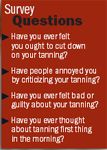- Case-Based Roundtable
- General Dermatology
- Eczema
- Chronic Hand Eczema
- Alopecia
- Aesthetics
- Vitiligo
- COVID-19
- Actinic Keratosis
- Precision Medicine and Biologics
- Rare Disease
- Wound Care
- Rosacea
- Psoriasis
- Psoriatic Arthritis
- Atopic Dermatitis
- Melasma
- NP and PA
- Skin Cancer
- Hidradenitis Suppurativa
- Drug Watch
- Pigmentary Disorders
- Acne
- Pediatric Dermatology
- Practice Management
- Prurigo Nodularis
- Buy-and-Bill
Article
Craving the rays
Tanners score higher on substance-use survey tool; Seasonal affective disorder may be one factor; Simple public health messages may be ineffective

Key Points

College students were asked to respond to questions about tanning behavior on a modified version of an instrument widely used to evaluate substance abuse.
Senior investigator Robin L. Hornung, M.D., Ph.D., says the survey tool "asks psychological questions of how participants feel."

Tailored tool
The instrument she used was a modified CAGE (cut down, annoyed, guilty, eye-opener) survey that has been used extensively with substance related disorders (SRDs).
"The sensitivity is reported to be 60 to 90 percent for alcohol addiction, depending on the study," when a subject responds positively to two or more of the questions, she says.
The study evaluated responses from 375 college students under the age of 30 who had reported ever purposefully tanning; 76 percent of females and 59 percent of males said they had. Females were more likely than males to use indoor tanning facilities (42 percent vs. 17 percent).
Some 12 percent of the overall sample scored positive on the CAGE. That rose to 18 percent among the self-reported tanners, and 28 percent among those who acknowledged using indoor tanning facilities. And the sample skewed heavily female (22 percent vs. 8 percent) among tanners with a positive CAGE score.
Dr. Hornung says the CAGE literature traditionally uses the term "disorder" for its measurement.
"I personally think it could be a disorder, if you are tanning frequently," she says. "You are aging your skin prematurely and increasing your risk for cancer."
SAD may be factor
Dr. Hornung acknowledges the possibility that some of these students in Seattle may be self-medicating for seasonal affective disorder (SAD).
"When we asked them why they tan, a majority of them said they did it to look better, but 41 percent said they did it because it was relaxing. So some of them might be attempting to self-medicate," she says.
A 2004 blinded, placebo-controlled study by Feldman found that participants reported "a more relaxed and less tense mood" when they used the UV tanning bed compared with a non-UV tanning bed. It concluded that "Frequent tanners can distinguish the two conditions and undertake further UV exposure, indicating that UV is a reinforcing stimulus."
Dr. Hornung's study did not ask about or control for the use of sunscreen. She suggests that nonuse of sunscreen might be a further indication of addiction.
One interesting finding was that women were significantly more likely than men to suffer a tanning disorder; that is the reverse of what is seen with most SRDs.
While most women indicated they tanned for cosmetic reasons, tanning may trigger psychosocial reward pathways similar to those triggered by substance use, and tanning is more socially acceptable, Dr. Hornung says.





